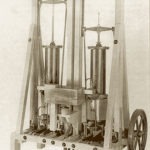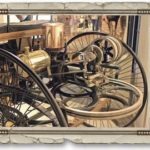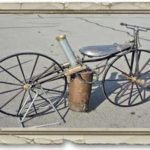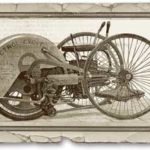Wheels keep on turnin
The first—or was it?
How many others have succeeded, but failed? It seems that history has more holes than a wheel of Swiss cheese. I discovered the Petrol-Cycle on the front page of the February 14, 1891 edition of the Scientific American. Invented by Edward Butler of Greenwich, England, this three-wheeled fore-car had an elegant 650cc twin-cylinder, four-stroke, water-cooled engine with electric spark ignition. Years ahead of DeDion and Boulton, the Petrol-Cycle made Gottleib Daimler’s Reitwagen look like something from the medieval period. Regardless, pick up any reference book on the history of motorcycles and you won’t find it mentioned.
Built in 1888 by the Merryweather Fire Engine Company in Greenwich, England, the Petrol-Cycle was driven by a 5/8 hp engine with a magneto ignition (later replaced by a coil and battery) and could attain a speed of 10 mph. It had Ackermann steering, rotary valves, and a float-fed carburetor—five years before Wilhelm Maybach invented his spray carburetor in 1893. The liquid-cooled engine had a water reservoir that doubled as a rear fender (an idea adopted by Hilderbrand & Wolfmuller in 1894) and the engine was started using compressed air.
Being ahead of your time isn’t always a good thing. The problem with Bulter’s creation wasn’t mechanical, but political. The English Red Flag Act (Locomotives On Highways Act) of 1865 limited all self-propelled vehicles to a speed limit of 2 mph in towns and 4 mph in rural areas. In addition, it required three people to attend to the vehicle, one of which had to walk in advance of the vehicle waving a red flag to warn people of its approach. In the 1890 issue of The English Mechanic, he wrote, “The authorities do not countenance its use on the roads, and I have abandoned in consequence any further development of it.” In 1896 he broke the Petrol-Cycle up for scrap and sold his patents to Harry Lawson, who manufactured the engine for marine use. Ironically, the Red Flag Act was repealed that very year.
Other than the steam velocipedes of Sylvester Roper, the history of motorcycles doesn’t begin until after the internal combustion engine had evolved. Count Albert DeDion and George Boulton had been producing steam vehicles since 1883, but when they developed their experimental internal-combustion engines, everything changed. The DeDion 1/2 hp, four-stroke, 138cc engine powered their first line of tricycles in 1895 and it was the franchising of this engine that gave birth to the modern motorcycle.
Sylvester Roper was a noted inventor who had the finances, access to state-of-the-art fabricating facilities, and extensive marketing connections to develop his passion for motorcycling. At least two of his business associates built and rode steam wagons as did Roper prior to 1867, and he actively promoted his steam velocipedes right up to the time of his death. However, a number of diverse elements had to be developed before motorcycles could become viable. One of these was the internal combustion engine.
History acknowledges that Gottlieb Daimler and Wilhelm Maybach built the first motorcycle with an internal combustion (IC) engine in 1885, and that Karl Benz built his two-stroke engine in 1879 to propel his three-wheeled Motowagen. Both Diamler and Maybach had worked with Nikolaus Otto, who developed the first successful gas engine. In fact, N.A. Otto & Cie is still in business. The story of the internal combustion engine didn’t begin in 1876 when Nikolaus Otto developed his four-stroke gas engine and Sir Dougald Clerk built the first successful two-stroke engine. Siegfried Marcus built four operational cars—the Strassenwagen—between 1868 and 1873, but it was Étienne Lenoir who developed the first practical gas engine in 1860. Running on benzine and utilizing electric-spark ignition, Lenoir’s engine powered a vehicle that he drove from Paris to Joinville in 1862.
Charles and Frank Duryea are recognized for manufacturing the first gasoline-powered cars in America (1893). Charles credits Samuel Morey for inventing the internal combustion engine and in the 1930s he financed the construction of two engines based on Morey’s patent. One is in the Smithsonian and Dean Kamen owns the other.
Like Edward Butler, Captain Samuel Morey was a man ahead of his time. He built and successfully operated steamboats years before Robert Fulton, and was the first to use side paddles for propulsion. He patented a rotary steam engine, developed a new method of producing “lamp gas,” patented a successful hot water heater using the same principle as modern ones, and then turned his attention to combustible gases. He not only built a “vapor engine,” but also installed it in a boat and a wagon in 1829. Little is known about the successful boat demonstration on the Schuylkill River in September, but he made history on Market Street in Philadelphia by being the first person in the United States to operate a gas-powered vehicle, and the second in the world to have an automotive accident.
Unfortunately, Samuel Morey’s patent was lost in the great Patent House Fire of 1836 and while Charles Duryea obviously had access to these papers, they once again became “lost” until being rediscovered in the archives of Dartmouth College in 2004. Utilizing valves, cams, a carburetor, and two cylinders, it is remarkably similar to internal combustion engines that would appear a half-century later. It ran on highly flammable spirits of turpentine and even had a wire mesh to prevent sparks in the combustion chamber from reaching the carburetor, a detail that would be independently reinvented in 1872. Samuel Morey was widely recognized for his accomplishments during his lifetime, yet he was unable to sell one of his most advanced patents and it became lost to history not once, but twice!
Samuel Morey’s engine predates the first commercial steam locomotive in America, but he wasn’t the first to experiment with internal combustion. A few months before Morey began designing his vapor engine, Samuel Brown patented an internal combustion engine on December 4, 1823 and built two working examples that were demonstrated at his home in Eagle Lodge in Brompton, England. He designed another engine in 1826 that used hydrogen and oxygen. Similar to a Newcomen steam engine, it had separate combustion and working cylinders, but water was circulated around the cylinder using a pump, and this water was cooled by contact with the outside air much like a modern water-cooled engine. This massive engine had a displacement of 8,800cc. Another source states the three cylinders had a bore of 12 inches and a stroke of 24 inches, but delivered only 4 hp. He mounted this on a four-wheeled vehicle and, in front of a small crowd, drove it up Shooter’s Hill in Greenwich on the morning of May 27, 1826.
Samuel Morey’s engine was much smaller and far more sophisticated than Brown’s, but both were, like Newcomen’s atmospheric steam engine, designed to create vacuum as the driving force. Still, neither of these men were the first to build operating IC engines, nor were they the first to drive a vehicle powered by such.
Based on a paper read before the Cambridge Philosophical Society in 1820, it’s apparent that Rev. W. Cecil built an experimental IC engine. The title of this paper, “On the Application of Hydrogen Gas to Produce A Moving Power In Machinery, With A Description of an Engine Which Is Moved By the Pressure of The Atmosphere Upon A Vacuum Caused By Explosions of Hydrogen Gas and Atmospheric Air,” seems to say it all. Rev. Cecil claimed that his engine ran at a steady 60 rpm and consumed 17.6 cu/ft of hydrogen per hour. The explosion took place in a cylinder and the engine apparently was quite noisy as he states: “To remedy the noise which is occasioned by the explosion, the lower end of the cylinder A, B, C, D may be buried in a well or it may be enclosed in a large air-tight vessel.” He also mentioned an engine that Professor Farish, a lecturer on mechanics at Cambridge, had demonstrated. The Farish engine ran on gas and air that mixed in a cylinder and exploded by atmospheric pressure, but he apparently built an earlier engine that was fired by gunpowder. These are the earliest internal combustion engines—or were they?
Looking through titles to U.S. patents filed prior to the 1836 fire at the patent office I notice several atmospheric engines listed. Unfortunately there’s no way to determine whether these were steam or gas engines unless they include the word “explosive.” There’s also no way to determine whether or not working engines were built for these patents.
One such example in 1811 was granted to Augustus Day of Bordentown, New Jersey, for his Combustion & Explosion Motor. He made improvements and filed another patent titled Explosive Power Motor on April 8, 1812. There are reputed to be published reports of this engine having actually been built. Of course, not all inventions were patented, nor all endeavors published. It has been alleged that John Sullivan had Marc Brunel build a gas-powered engine that was used to propel a boat in Hoboken, New Jersey, in 1798 or 1799. Considering the achievements of both men, this claim is plausible and might be one of those forgotten events in the history of motorized transportation.
Experiments with internal combustion were taking place in Europe even as James Watt’s new steam engine was starting to be commercialized. John Barber’s patent of 1791 was for an engine powered by the combustion of hydrocarbons and air. The hydrocarbons would be created by the external burning of wood, coal, oil, or other combustibles and then mixed with air in a second container he called the “exploder.” The flash from the ignited gas would turn a paddlewheel or fan. Robert Street designed a compressionless piston engine in 1794. His proposal had coal tar, spirit or turpentine rendered gaseous and then ignited by a flame burning outside the cylinder. The combustion forced the piston upwards and moved a weight. Philippe Lebon d’Humbersin patented, but never built, a machine driven by illuminating (coal) gas in 1801. Two pumps compressed air and gas separately, and these were released into a vessel where the mixture was to be ignited. The expansion of these gases overflowed into a double-acting cylinder and provided working power on both ends of the cylinder. He even suggested using electricity for the ignition, and that both the generation of this electricity and the two compression pumps be run by the motor itself.
Francois Issac de Rivaz, a Swiss inventor, patented an internal-combustion engine in 1807. The engine was fueled by hydrogen and oxygen, stored in a balloon that was electrically ignited by a hand-operated trigger. Fitted to a crude four-wheeled wagon, the first test drive of 100 meters took place in 1813, thus making history as the first vehicle known to have been powered by an internal-combustion engine.
Like layers of an onion, the history of internal combustion keeps getting peeled back layer by layer. William MacGregor, in his 1885 work on gas engines, gives credit for their invention to the famous inventor and philosopher Abbe Hautefeuille in 1678. Most historians agree that in 1673 Christiaan Huyghens was the first to describe a cylinder and piston in a “powder” machine, but there’s no record of this machine having been more than a concept on paper. On January 16, 1206, the famous artist/scholar/ astronomer/mechanical engineer al-Jaziri published his Book of Knowledge of Ingenious Devices. Among the 50 mechanical devices illustrated, he presents an ingenious water pump. The diagram looks like a 1950s vintage straight-six engine and is actually the earliest known documentation of a camshaft, reciprocal pistons, and sequenced valve system. While al-Jaziri’s water pump had nothing to do with internal combustion, it was the form that function would ultimately follow seven centuries later.
























Thanks for the sensible critique. Me and my neighbor were just preparing to do a little research about
this. We got a grab a book from our local library but I
think I learned more from this post. I’m very glad to see such fantastic information being shared freely out there.